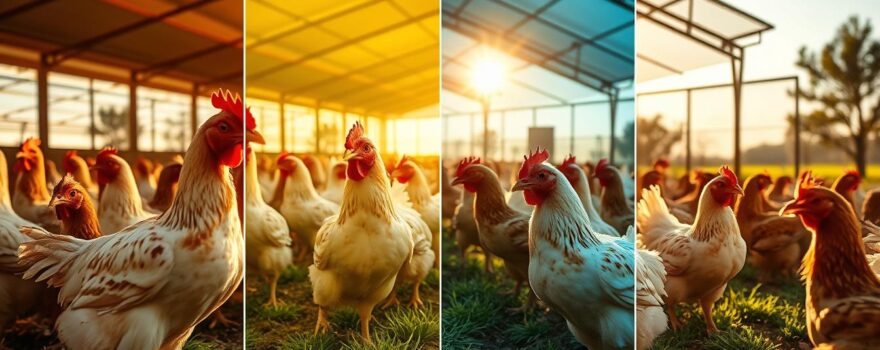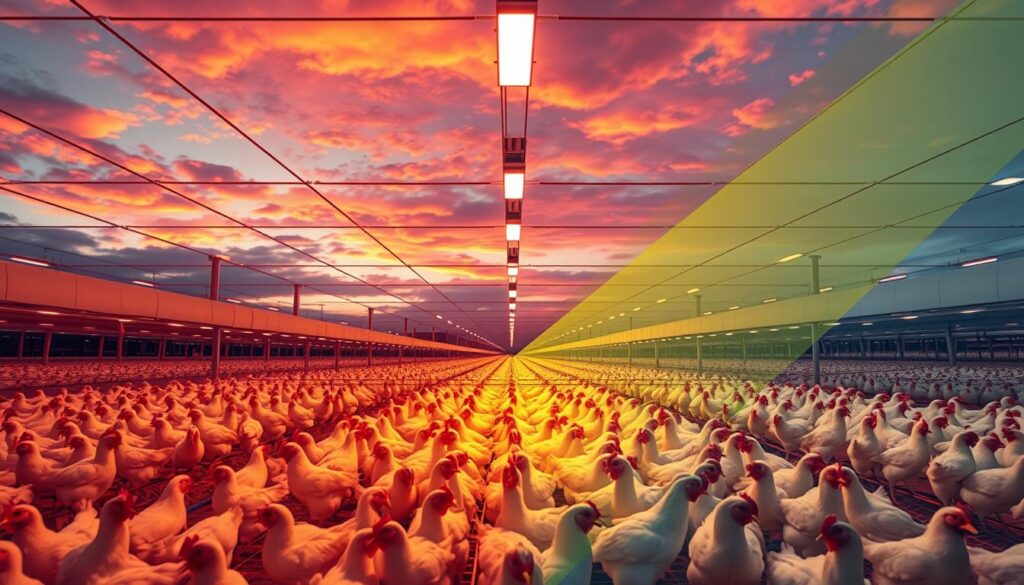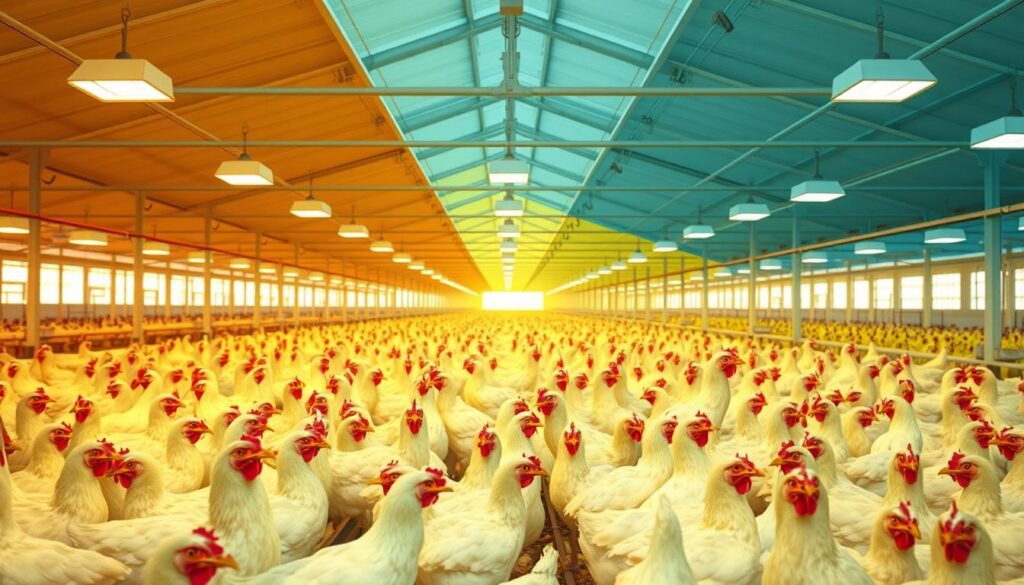
The role of lighting in poultry farming is growing. It helps set a rhythm for broiler chickens and affects their growth. The right lighting is key to better growth and health in broilers.
Broiler chickens need the right light intensity, duration, and color. This is important for their growth and well-being. Modern farms rely on good lighting to raise healthy broilers.
Key Takeaways
- Proper lighting regimen is essential for optimizing broiler growth and productivity.
- Lighting programs should consider factors like intensity, duration, and wavelength to enhance broiler performance.
- Broiler performance and welfare are maximized when providing 17 to 20 hours of light per day.
- Lighting programs should be integrated with other environmental factors to achieve optimal results.
- Automated lighting control systems can help maintain consistent and energy-efficient lighting programs.
Understanding the Importance of Light Regimen in Broiler Production
Light’s Impact on Broiler Physiology and Behavior
The quality and length of light greatly affect broilers. They see light through rods and cones in their eyes. Cones help them see colors and bright lights. Rods are better for seeing in the dark but can’t see colors.
Light can even reach the broiler’s brain. The pineal gland and hypothalamus turn this light into responses. These responses affect their body’s rhythms and activities.
Research shows that broiler lighting affects their growth, how well they eat, and their health. Managing broiler lighting and light regimen effects is key. It helps improve broiler production and their well-being.
“Light is a critical environmental factor that influences the physiology, behavior, and productivity of broiler chickens.”
Evaluating Different Light Sources for Broiler Chickens
The poultry industry is always looking for better lighting for broiler chickens. In the past, incandescent bulbs were common but now they’re not used much because they use a lot of energy. Today, options like cold cathode fluorescent lamps (CCFL), compact fluorescent lamps (CFL), and LEDs are being considered.
LED lighting is seen as a new way to help broilers grow better. Research shows that LED light can improve hatch rates and chick health. It also boosts the immune system of broilers. This makes LED lighting a strong contender for poultry farms.
LED lamps use much less energy than old bulbs. They are also smaller and last much longer. This makes them a smart choice for farmers looking to save money and energy.
Studies have found that LED lighting can really help broilers. They grow faster, are healthier, and use less energy. This is good news for farmers looking to improve their operations.
“The positive effects of using LED lamps included enhanced growth performance, final body weight, behavioral activities, egg production yield, and reduced electric energy costs.”
LED lighting is a game-changer for the poultry industry. It’s a step towards making farming more efficient and green. As we look for ways to save energy and money, LED lighting for broilers is a promising solution.
Optimizing Light Intensity for Broiler Growth and Welfare
Finding the perfect light for broilers is key for their growth and health. In the U.S., broilers get 20 lux of light for the first week. Then, they get 3 to 5 lux for the rest of their time in the coop.
In Europe, broilers get at least 20 lux before they are 7 days old. This light is then slowly reduced to 10 lux until they are 21 days old. After that, they stay at 10 lux. Experts agree that 5 lux is the minimum light needed for their well-being.
High light in the early days helps chicks adjust and eat well. Lower light later on helps them grow heavier by moving less.
“A reasonable light regimen is crucial for the growth of broilers in modern farms, impacting feed conversion efficiency and growth performance.”
– Dr. Hank Classen, Poultry Nutrition Researcher
Dr. Karen Schwean-Lardner found that 17 to 20 hours of light is best for broilers. More than 23 hours can harm their growth and health.
By managing Broiler Light Intensity well, farmers can improve their chickens’ lives. This leads to better Broiler Welfare and Lighting and growth.
Lighting Programs for Broiler Chickens: Maximizing Growth and Efficiency
For a long time, people thought long days helped chickens grow more. But new studies show this isn’t true. A team from Aviagen and the University of Saskatchewan looked into how light affects broiler chickens.
They found that 23 hours of light isn’t the best. It can hurt growth, how much they eat, and their health. But, chickens do best with 17 to 20 hours of light.
Research says chickens need four hours of darkness for the best growth. This helps them feel more natural. For the most efficient eating, chickens need 10 hours of darkness.
“The lowest mortality and culls occurred under 17 hours of light and seven hours of darkness, indicating a reduction in mortality rates with increased darkness periods.”
More darkness helps chickens move better and live healthier lives. It also makes them less likely to have bone problems. This shows how important light is for their well-being.
Darkness helps chickens follow their natural day-night cycle. It affects their hormone levels and how they behave. Different light times change how they feel and act, showing the need for Broiler Lighting Programs.
The new code of practice suggests changing lights slowly to keep chickens calm. It recommends a dawn-to-dusk system for the best health and Optimal Lighting for Broiler Growth.
Managing Light Duration for Broiler Chickens
Early Growth Phase Lighting Strategies
Light management is key for broiler chickens’ growth and well-being. In the early stages, a steady Broiler Light Duration helps them adjust and stay productive.
Research indicates that broilers thrive with 17 to 20 hours of light daily. However, too much light, like 23 hours, can harm their Light Schedule for Broilers. It can slow their growth, reduce feed intake, and lower processing quality. It also increases mortality and welfare problems.
To ease the transition to dark periods, keep lights on for the first 24 hours. Then, from the 2nd to the 7th day, turn them off for 1 hour at night. This gradual change helps broilers find their way and food, boosting their health and performance.
“Broiler performance and welfare are optimized when between 17 and 20 hours of light are given, with all darkness provided in one period.”

By using these lighting strategies in the early growth phase, producers can ensure their broilers get the best Broiler Light Duration and Light Schedule for Broilers. This leads to better Lighting Regimen for Broiler Growth and more efficient production.
Light Color and Wavelength Considerations
Broiler chickens see the world differently than humans. They have a wider range of colors and are more sensitive to light. This sensitivity can greatly affect their growth and well-being. Scientists have been studying how different light colors and wavelengths impact broilers.
Broiler Light Color and Monochromatic Lighting for Broilers are key topics. Studies suggest that yellow LED light might be better than traditional green, blue, and incandescent lights. Yellow LED light, known as “human-friendly,” helps broilers grow heavier and produce less manure.
The Wavelength Effects on Broilers have been well researched. Chickens can see ultraviolet (UV-A) light, in addition to the visible spectrum. They are most sensitive to light around 480 nm and 630 nm. The light’s intensity, measured in Clux, can be up to 50% more than Lux, depending on the source.
| Light Source | Wavelength Range | Broiler Performance Impact |
|---|---|---|
| Blue LED | 400-500 nm | Enhances growth |
| Green LED | 500-565 nm | Enhances growth |
| Yellow LED | 565-590 nm | Increases body weight gain, reduces manure output |
Finding the right light intensity for broilers is important. Too little light, below 5 Lux, hinders growth. Too much, above 50 Lux, can stress the birds. Managing light color, wavelength, and intensity is key to their health and growth.
Integrating Light Regimen with Other Environmental Factors
Raising healthy broiler chickens needs a full plan. This plan must include lighting and other key environmental factors. It’s important to match light levels, color, and time with temperature, humidity, air flow, and radiation. This ensures the best performance and care for the chickens in today’s farms.
Studies show how important the environment is for broilers. For example, a study with 1,584 Cobb 500 broilers found that light levels of 5, 10, and 20 lux didn’t affect growth. But, a feeding preference trial with 180 Cobb 500 broilers showed that 20 lux was the most preferred during meals.
This shows that while light intensity might not directly affect growth, chickens prefer brighter lights, especially when eating. By understanding Broiler Environment and Lighting and other factors, producers can make a better Lighting and Other Factors for Broilers plan. This plan helps with both productivity and animal care.
| Environmental Factor | Potential Impact on Broilers |
|---|---|
| Temperature | Affects feed intake, growth, and thermoregulation |
| Humidity | Influences respiratory function and heat dissipation |
| Air Velocity | Impacts heat stress and litter quality |
| Radiation | Affects bird comfort and energy expenditure |
By Optimizing Broiler Environment with these factors, producers can make a better place for their chickens. This place supports their health, welfare, and productivity.

“Integrating light regimen with other environmental factors is crucial for maximizing broiler growth and efficiency in modern poultry production.”
Lighting Automation and Control Systems
The modern broiler industry is seeing big changes in lighting technology. Automated poultry lighting systems are now key. They can control light duration, intensity, and color to help broilers grow better and stay healthy.
Light-emitting diode (LED) technology is a big step forward. It’s more energy-efficient and lasts longer than old lighting. LED systems can adjust light levels to match what birds see, called “galli-lux.”
These systems can change light settings based on the birds’ age and the environment. This ensures they grow well and use feed efficiently.
| Feature | Benefit |
|---|---|
| Precise Light Intensity Control | Maximizes feed distribution and flock uniformity |
| Automated Light Duration Adjustment | Enhances growth and productivity |
| Adaptable Light Spectrum | Promotes optimal physiological responses |
Using these advanced lighting systems, broiler farms can reach their best performance. This means better feed use, weight gain, and overall flock health.
“The study indicates that light plays a vital role in affecting the growth and development of poultry.”
As the broiler industry grows, using automated poultry lighting, lighting control systems for broilers, and precision lighting will be key. It will help make broiler farming more sustainable and efficient.
Lighting is key to growing broiler chickens well. It must match the light source, intensity, color, and how long it lasts. Studies show that 17-20 hours of light a day, all at once, is best. This is different from the old idea that more light is always better.
New lighting tech like LED and automated systems help. They let farmers fine-tune the light for better broiler productivity and sustainability.
This article has shown the Broiler Lighting Best Practices. It also talked about how to Optimizing Broiler Growth with Lighting and the need for good Lighting Programs for Broiler Production. These tips help farmers make their flocks grow better and be healthier.
By using the latest research and tech, farmers can make their operations better. This leads to more quality poultry products.
The industry will keep changing, and lighting will play a big role. Knowing how to use light well is key to success. By following the best broiler lighting practices, farmers can keep their businesses strong and sustainable.